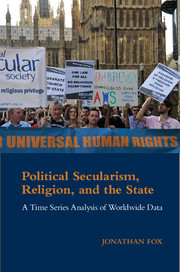Book contents
- Frontmatter
- Contents
- Acknowledgments
- 1 Introduction
- 2 Secularism or Secularization? The Secular-Religious Competition Perspective and Beyond
- 3 Establishment, Support, Neutrality, or Hostility: The Varieties of Official Religion Policy
- 4 State Support for Religion
- 5 Regulation, Restriction, and Control of the Majority Religion or All Religions
- 6 Religious Discrimination
- 7 Education, Abortion, and Proselytizing
- 8 Religion in Constitutions
- 9 Conclusions
- Appendix Data Collection and Reliability
- Bibliography
- Index
3 - Establishment, Support, Neutrality, or Hostility: The Varieties of Official Religion Policy
Published online by Cambridge University Press: 05 May 2015
- Frontmatter
- Contents
- Acknowledgments
- 1 Introduction
- 2 Secularism or Secularization? The Secular-Religious Competition Perspective and Beyond
- 3 Establishment, Support, Neutrality, or Hostility: The Varieties of Official Religion Policy
- 4 State Support for Religion
- 5 Regulation, Restriction, and Control of the Majority Religion or All Religions
- 6 Religious Discrimination
- 7 Education, Abortion, and Proselytizing
- 8 Religion in Constitutions
- 9 Conclusions
- Appendix Data Collection and Reliability
- Bibliography
- Index
Summary
In 1995, after decades of discussion and debate, the government of Sweden and the (Lutheran) Church of Sweden decided to separate from one another, a separation that took place officially in 2000. This decision had numerous practical results. Local parishes and the government had to appraise and divide vast amounts of property. The Church received significantly less government support, which forced it to drastically cut its budget. The king was no longer required to be a Lutheran, and the government no longer appointed the Church's bishops. Children of at least one Lutheran parent are no longer automatically Church members. To join the Church, they must be baptized into it.
Even so, this was not a total victory for the advocates of political secularism. Like most cases of shifts in state religion policy, which are part and parcel of the secular-religious competition perspective, neither Sweden's starting point nor its ending point were absolute support for religion or total secularism. Rather, it was a shift from one point on the spectrum between the two to another. Many states support religion more than Sweden did before it disestablished the Church of Sweden, and the new separation was not a complete one. For example, the Church still receives fees through taxes but gets these funds on an equal basis with other religions. Taxpayers may choose to divert the tax to the religious group of their choice or receive a tax reduction.
As we will see in this chapter, a shift of this magnitude in state religion policy is rare, but it illustrates one of the most basic choices involved in government religion policy – whether to have an official religion. Yet like most choices involved in state religion policy, this choice is not as black and white as it seems. There are significant differences among states with an official religion as there are among states with no official religion.
- Type
- Chapter
- Information
- Political Secularism, Religion, and the StateA Time Series Analysis of Worldwide Data, pp. 39 - 63Publisher: Cambridge University PressPrint publication year: 2015



